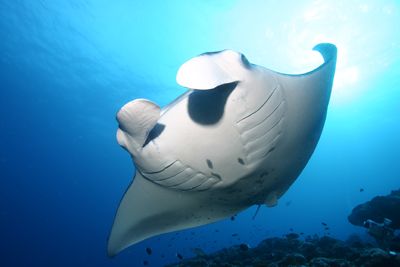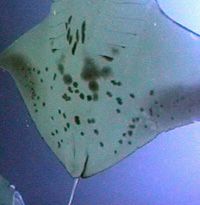The Manta Ecology Project

Until as recently as 20 years ago very little was actually known about manta rays and this project was initiated to study the behavioural ecology of mantas from observations in the field.
The project began in November 2001 whilst we worked as dive guides in the Maldives. High on the diver’s wish list was a dive with manta rays (Mobula alfredi
is the species we commonly see in the Maldives) so every week a number of dives were made at known cleaning stations in order to observe them. We were not sure whether we saw the same mantas every week or different ones so we developed an method to identify them individually based on the spot markings based on the ventral side of each manta (see Compare Mantas for more information on identification).

In 2005 the project was formalised as as a research project under the supervision of Newcastle University and resulted in a Ph.D award to Project Director Anne-Marie Kitchen-Wheeler in 2013. The project included development of an ACCESS database to store the burgeoning data on mantas identified. There are now well over 3000 identified mantas logged in the database from an estimated population of around 12,000 and the database continues to grow by about 200 new mantas each year. We continue to visit the established sites plus we identify new sites partly using our understanding of where mantas go and partly as access to more remote areas of the Maldives has developed. It appears that there are fairly fixed populations of mantas in each atoll, but the individuals move around between the various cleaning stations and feeding areas. We have now been sighting the same mantas for over 20 years!
We now know there are likely two species of manta ray, the Alfred manta (Mobula alfredi) and the larger, more pelagic, giant manta (Mobula birostris) shown in photo below (photo: John Rochester). A genetically separate putative species has also been identified from the Caribbean. Mobula birostris is found across the world in tropical waters and occasionally travels into colder water with regular reports as far north as New Jersey USA and possibly from Newfoundland and as far south as New Zealand. It grows to at least 6.8m disc width (DW) and has a distinctive cartilaginous mass just behind its dorsal fin which covers a spine. Mobula alfredi is smaller, growing to about 5m DW and is reported mainly from tropical reefs in the Indopacific region.

Current research projects include investigations into the social behaviours of individual mantas, including whether they form groups and close associations, agonistic behaviours between individuals to determine priority at cleaning stations and co-operative behaviour whilst feeding.
Medium term projects are investigating the movements of both individual mantas and populations of mantas. We were proud to be involved in the IUCN Maldives Monitoring and Awareness programme and spent several years in the mid 2010's training up marine biologists and diving instructors and dive masters to collect data on the manta rays they observed. There is now the option for anyone to send photos of mantas they have encountered to
MantaMatcher.org and this has been a major source of sightings data since 2016. By increasing the number of reports of encounters and the area from which the observations are being made from we hope to significantly increase the number of manta rays sighted. Our target is to include the majority of the entire Maldives manta ray population in our database.
If you have any photos of mantas from the Maldives please upload to www.mantamatcher.org and it is important to select "Maldives" from the location list
Our other research projects continue, including a study on cleaning ecology, the ecology of the isolated population of Addu atoll and a study of juvenile mantas in sheltered lagoons.
We encourage interested divers to support our research by sending photos and videos of their holiday encounters. We continue to visit the Maldives and contribute to our research data. We are also looking for funding to help us complete a Maldives wide migration studies project. If you can help sponsor this project please contact Anne-Marie.
